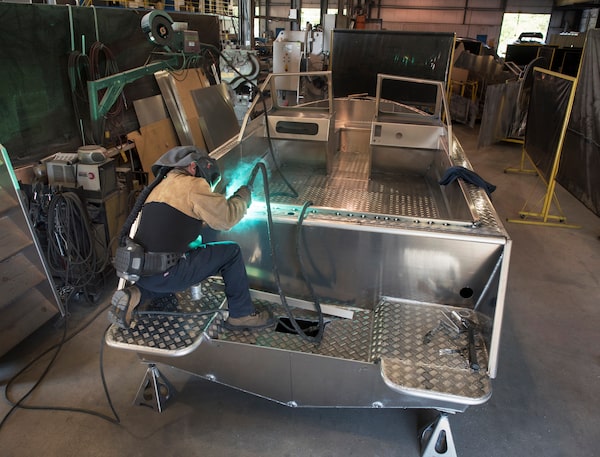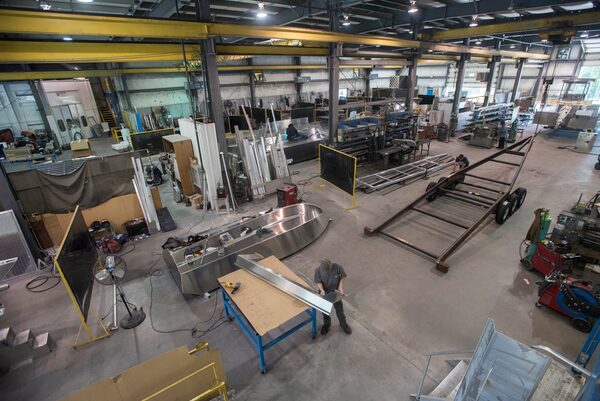Dan Reed does welding on a 20' Islander recreational boat.Fred Lum
U.S. President Donald Trump promised to disrupt the way America trades. Two months after he imposed tariffs on steel and aluminum, sparking a trade war with Canada, the European Union and other countries, disruption is exactly what he has created.
The tariffs are driving up metal prices, redrawing supply chains and threatening jobs in some places. The marine industry is one example of the rapid shifts created by Mr. Trump’s tearing up of the global trade order.
Michael Szwez, marketing director at Canada Metal Pacific Ltd., a Delta, B.C.-based company that makes equipment for commercial ships and recreational boating, said the company’s markets for raw materials and finished goods have been hit “all around” by tariffs in China, the United States and Canada.
“It’s affecting our margin and affecting the bottom line. In a lot of cases, we’re not able to pass on the increase so we’re trying to find creative ways to absorb it whatever way we can and cut costs internally,” Mr. Szwez said.
The company’s products, including anchors, dock ladders and remote steering systems, are made in Canada or China of steel, aluminum and resins, and mainly sold in Canada and the United States.
Mr. Szwez said the 25-per-cent tariff on steel and 10-per-cent levy on aluminum across his supply chain have spurred the company to turn its Virginia distribution centre into a manufacturing plant, a move he conceded is “not great for Canada.” The new plant employs 20 and will grow as production rises, but is vexed by a shortage of machinists and tool-and-die makers.
“It’s the only solution that we can see to overcome this,” he said.
Mr. Trump imposed the metal tariffs on imports from Canada, Mexico and the European Union as of June 1 in a stated bid to restore U.S. manufacturing jobs in the sector. He also levied new tariffs on a wide array of Chinese goods and has threatened more.
Canada and other countries have responded in kind, touching off an escalating battle even as negotiations continue toward a renewed North American free-trade deal.
Trade wars are a theme the President returns to again and again. On Sunday, he wrote on Twitter: "Tariffs are working big time. Every country on Earth wants to take wealth out of the U.S., always to our detriment. I say, as they come, tax them. If they don’t want to be taxed, let them make or build the product in the U.S. "

The tariffs are driving up metal prices, redrawing supply chains and threatening jobs in some places.Fred Lum/The Globe and Mail
But the steel and aluminum jobs Mr. Trump says he is creating or protecting through tariffs could come at a steep cost.
For every job gained in U.S. aluminum and steel industries, 16 other jobs will vanish as consumers facing higher costs of goods cut spending, according to Trade Partnership Worldwide LLC, an economic consultancy based in Washington, D.C.
The U.S. tariffs on steel and aluminum will cost a net 402,000 jobs in the United States as other countries retaliate with their own tariffs, the group said in a recent report. The total job losses include more than 6,000 agriculture jobs and 91,000 jobs at companies that manufacture goods with steel and aluminum and which now face higher costs.
“This is what the textbook says you should do,” said Dan Ciuriak, a trade expert at the C.D. Howe Institute and a former deputy chief economist at the Department of Foreign Affairs and International Trade. “You go tit-for-tat [with retaliatory tariffs] … the question whether it’s going to work or not is an open one.”
“What is rational from the standpoint of the Trump administration is not necessarily what is rational by conventional economic thinking and this of course is puzzling or bedevilling U.S. trade commentators as well as those around the world,” he said.
Canada is the United States' biggest metal supplier, providing 40 per cent of the country’s aluminum and 18 per cent of its steel.
At the same time, the United States is Canada’s biggest market for aluminum and steel. Canadian aluminum exports to the United States are worth $11-billion, compared with $3.9-billion in U.S. imports, said Matthew Stewart, director of economics at Conference Board of Canada.
Mr. Stewart said domestic aluminum prices should have fallen after the tariffs were put in place, as Canadian producers of aluminum supposedly reduced prices to win local sales and make up for lost sales to U.S. customers.
But that’s not what’s happening, said Bill Connor, owner of Connor Industries, which makes heavy aluminum watercraft for commercial purposes, such as police and fire boats.

Photographs of boats being built in the Stanley Boats manufacturing plant in Parry Sound, Ont.Fred Lum/The Globe and Mail
Mr. Connor said that even before the Canada-U.S. tariffs went in place, prices for aluminum sheet from mills in Quebec and the United States shot up by about 11 per cent. With the tariffs in place, prices rose again.
“They have added another round of increases. I don’t understand the justification for it. They tell me the world price, which is in U.S. dollars, has gone up because of the demand. I don’t know if I totally buy that,” said Mr. Connor, whose businesses include Stanley Boats, a 50-employee boat yard in Parry Sound, Ont., and MetalCraft Marine in Kingston, which employs 80. He also owns a boat factory in Cape Vincent, N.Y., with a staff of 14.
Mr. Connor also faces rising prices for steering systems, lights and other equipment made in the United States from Chinese metals.
He figures 30 per cent of his supply costs are affected by the U.S. tariffs on Chinese steel and aluminum. Mr. Connor protected himself by hedging aluminum purchases until the end of July. But he said he might be forced to consider raising prices, a step he tries to avoid in the middle of the summer boating season.
Mr. Connor is in the midst of opening a new 10,000-square-foot plant in Florida that will be producing boats by next summer. The U.S. factory will give him access to a larger market, tariff free, as well as making it easier for the company to bid on U.S. government boat contracts. It’s a move he began even before the tariffs went in place, spurred by tax incentives offered by the local governments.
Mr. Szwez of Canada Metal said he, too, has seen Canadian metal prices rise. And the company is having trouble replacing imported steel and aluminum with domestic sources, which can be of different grades and in short supply.
The C.D. Howe Institute’s Mr. Ciuriak said the higher prices on tariff-free domestic aluminum are “hardly surprising.” He noted U.S. domestic steel prices rose, as well.
“When you put up tariffs, companies tend to price up to the tariff,” he said by phone. “You have an oligopoly taking an advantage of the tariffs to raise its margins and that is to be expected.”
 Eric Atkins
Eric Atkins